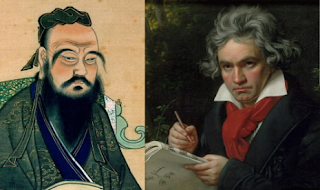Music is a universal language that transcends borders, cultures, and time. Its evolution reflects the history, spirituality, and artistic expressions of civilizations across the globe. While Western music has dominated global popular culture in recent centuries, Eastern musical traditions have deeply influenced its development. This article explores the evolution of music from ancient Eastern traditions to the modern Western world, highlighting key innovations, cultural exchanges, and stylistic transformations.
1. Ancient Eastern Musical Traditions
A. Mesopotamia and Egypt: The Birth of Organized Music
Music’s origins can be traced back to ancient civilizations in Mesopotamia (modern-day Iraq) and Egypt (3000 BCE). These cultures developed early forms of musical notation, instruments like the lyre and harp, and used music in religious rituals and royal ceremonies.
B. Indian Classical Music: The Science of Sound
Indian classical music, rooted in the Vedas (1500 BCE), is one of the world’s oldest musical systems. It is built on ragas (melodic frameworks) and talas (rhythmic cycles). Instruments like the sitar, tabla, and veena define its rich tonal textures. The concept of microtones (shrutis) influenced later Middle Eastern and Western music.
C. Chinese Music: Harmony with Nature
Ancient Chinese music (2000 BCE) was deeply connected to Confucianism and Taoism. The pentatonic scale (five-note scale) became fundamental, and instruments like the guqin (zither) and pipa (lute) were developed. Chinese opera later integrated music, drama, and poetry.
D. Persian and Arabic Music: The Maqam System
Persian and Arabic music introduced the maqam system, a complex modal structure that influenced later European medieval modes. Instruments like the oud (predecessor of the lute) and ney (flute) were pivotal in shaping Middle Eastern and Mediterranean music.
2. The Spread of Eastern Music to the West
A. The Silk Road: Cultural and Musical Exchange
The Silk Road (2nd century BCE–15th century CE) facilitated the exchange of musical ideas between Asia, the Middle East, and Europe. Instruments like the lute (from the Arabic oud) and violin (from Central Asian fiddles) traveled westward.
B. Islamic Golden Age (8th–14th Century)
Muslim scholars like Al-Farabi and Avicenna wrote extensively on music theory, influencing European medieval music. The Andalusian musical tradition in Spain blended Arabic, Jewish, and Christian styles, leading to flamenco and early European classical forms.
C. Byzantine and Gregorian Chant
Eastern Orthodox Byzantine chant (4th century CE) and Western Gregorian chant (9th century CE) laid the foundation for sacred music. The split between Eastern and Western Christianity led to distinct musical developments—Byzantine music remained monophonic, while Western music evolved into polyphony.
3. The Renaissance and Baroque: Western Music’s Rise
A. Renaissance (1400–1600): Polyphony and Humanism
The Renaissance saw the rise of polyphony (multiple melodies), with composers like Palestrina and Josquin des Prez. The printing press helped spread musical notation, while Eastern scales subtly influenced Western harmonies.
B. Baroque Era (1600–1750): Ornamentation and Emotion
The Baroque period introduced basso continuo, opera, and instrumental music. Composers like J.S. Bach and Vivaldi used intricate ornamentation, possibly inspired by Middle Eastern and Indian melodic embellishments.
4. Classical and Romantic: Western Dominance with Eastern Inspirations
A. Classical Era (1750–1820): Symmetry and Form
Mozart and Haydn established structured forms like the sonata and symphony. Some works, like Mozart’s "Rondo Alla Turca", imitated Ottoman military music (Janissary music).
B. Romantic Era (1820–1900): Exoticism and Nationalism
Composers like Rimsky-Korsakov ("Scheherazade") and Debussy (influenced by Javanese gamelan) incorporated Eastern scales and rhythms. The Orientalism trend romanticized Middle Eastern and Asian sounds.
5. 20th Century: Globalization and Fusion
A. Jazz and Blues: African and Eastern Influences
Jazz musicians like John Coltrane studied Indian ragas, while Miles Davis incorporated Middle Eastern modes in "Kind of Blue."
B. Rock and Psychedelia: The Sitar in Western Pop
The Beatles (George Harrison’s sitar in "Norwegian Wood") and Ravi Shankar popularized Indian classical music in the West.
C. Electronic and World Music Fusion
Modern artists like Dead Can Dance, Peter Gabriel, and Bollywood-Western collaborations blend Eastern and Western sounds seamlessly.
6. 21st Century: Digital Age and Cross-Cultural Music
Today, K-pop, Afrobeats, and global EDM showcase a fusion of Eastern and Western elements. Streaming platforms allow instant cultural exchange, making music more interconnected than ever.
A Never-Ending Musical Dialogue
From ancient ragas to modern pop, music’s evolution is a story of cultural exchange. Eastern traditions provided the roots, while Western innovations expanded its reach. As globalization continues, the future of music lies in hybridity—where East and West create harmonies beyond borders.
Music, in its essence, remains humanity’s shared heritage.





No comments:
Post a Comment